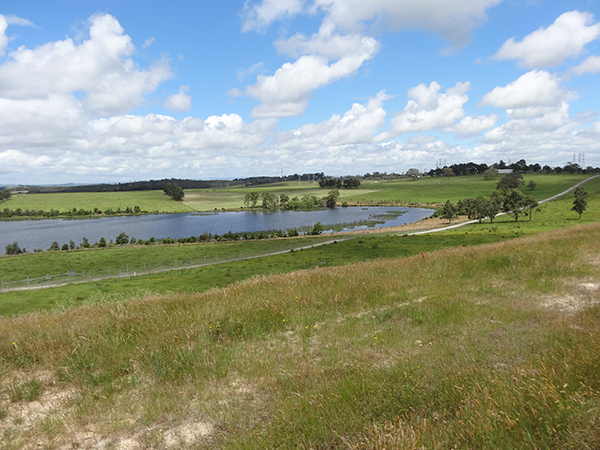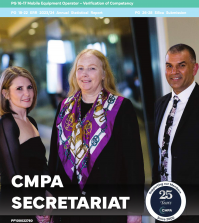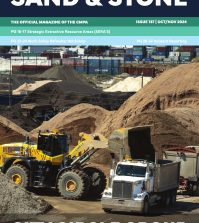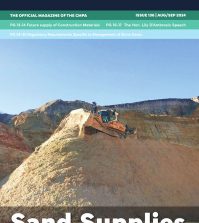Voting Members Spotlight
Supporting the Extractive Industry for 20 years
GAVIN MOREIRA, Members Services Manager of the CMPA reflects on the first 20 years of the association.
The inaugural meeting of small to medium sized extractive industry organisations was held on the 6th September 1999 at the BP Service Station on the corner of Cooper Street and the Hume Highway in Somerton (which is still in existence today).
Your association was formed to guide and assist its members, to enhance the viability of their respective business units and to maximise cost savings for the group. The association was also formed to represent members on nominated legislative matters of common interest, to limit legal risk and to standardise documentation within business units wherever practical. To foster unity along with internal and external cooperation for the association and set priorities with the aim to improve outcomes for the common benefit.
In search of these goals a management committee was formed and in turn specialist committees were later set up to provide expert consideration of and representation towards problems raised by the membership. (extract from Issue 1. CMPA News written by the Editor Mike McCann)
The management committee’s inaugural Chairperson was Ron Kerr, now Honorary CEO who is still very much a driving force behind the CMPA and for the present and future existence of small to medium sized businesses in the extractive industry.
The purposes of the Association are to:
- conduct its affairs with honesty and integrity;
- demonstrate its commitment to the:
- viability of the Industry;
- protection of the environment;
- community in which it exists;
- vigorously pursue with government and others, issues of widespread concern to members;
- demonstrate leadership and a sense of direction for the Industry;
- act as a resource and provide support to its members through the delivery of cost savings and assistance in complying with legal obligations;
- foster unity and cooperation between members and others;
- promote continuous improvement through education, training and other activities

Key Milestones

The past 20 years has seen the CMPA represent members and the industry on various issues; the following are five key issues that the CMPA has had to deal with since inception and are still working through with regulators and governments today.
Rehabilitation Bonds
The interpretation and enactment of existing legislation through the bond calculator has resulted in unjust and unequitable outcome. In 2000 rehabilitation bonds for the extractive industry $31.39 million by 2018 they were $92.2 million – an increase of 11% per annum. Since inception in 2000, the CMPA has continuously raised concerns, always being advised that the commercial impact of the tool was coming to an end.
- No complying Work Authority has ever been cancelled.
- The Minister has never used their powers on a significant rehabilitation for a construction material Work Authority since the enactment of the 1966 EI Act.
- There is no evidence of financial failure of any Work Authority in last 25 years on private land.
- There is no evidence of environmental failure on a Work Authority site failing in the last 25 years on private land.
- There is no evidence of prosecution of a significant environmental failure on a Work Authority site on private land.
- There is only evidence of $18,000 of rehabilitation being picked up by the Minister in recent memory.

Dust (Respirable Crystalline Silica)
The CMPA has raised issues surrounding Respirable Crystalline Silica dust (RCS) with quarry operators with the intent of lifting the standards in the extractive industry. CMPA is very much aware of RCS and the potential adverse impact on employees’ health and has been instrumental in raising this issue and subsequently compliance among Members through:
- CMPA pre employment health assessment proforma;
- CMPA periodic health assessment proforma;
- CMPA exit employment health assessment proforma;
- CMPA instructions for medical practitioners;
- Work Safely Reference Manual;
- Holding dust workshops 2016 and 2019;
- Development of the CMPA Dust Management Guideline March 2016;
- Delivering dust training;
Submissions over the years including written and oral submissions made by CMPA to the Senate Community Affairs References Committee “Workplace Exposure to Toxic Dust” 29 September 2005. The CMPA submission highlighted the need for consistent and systematic enforcement of Workplace Exposure Standards (WES) for Respirable Crystalline Silica (RCS). This was supported by submissions from other organisations.
Native Vegetation
The extractive industry recognises a significant amount of Victoria’s native vegetation has been cleared because of the growth and economic development of the State. The industry also understands that the remaining native vegetation is important for maintaining catchment health and protecting flora and fauna habitats.
There is now a stronger emphasis by DELWP on the avoidance of native vegetation removal through the use of enforcement as opposed to through the use of encouragement for people to keep native vegetation.
- For removal of native vegetation <0.5 hectare a consultant is needed which was not required previously.
- Overnight, the possible presence of a threatened species was removed with a different threatened species being added.
- The process relies heavily on modelled vegetation data, though, there is the potential to use site specific data (at a cost).
- The process for submitting digital data is onerous in particular for large trees, which were previously part of the habitat hectare now have to be counted and measured which is expensive and time consuming.
- The definition of native vegetation now includes post disturbance re-vegetation.
- All previous native vegetation removal/clearing permits for the last 5 years need to be obtained from the local council.
- The emphasis is now on habitat rather than species, however, in many cases there is no accepted definition of habitat. For example, the swift parrot or temperate rain forest. Judgements may be made but these are open to being challenged.
In summary, the Native Vegetation Removal Regulations are now even more onerous and cumbersome than the previous regulations with the extractive industry having to purchase costly native vegetation offsets, that is, if they are available.

Planning / WA approvals process
Recent progress has been made with the Work Authority approvals process with respect to the Commissioner for Better Regulation Anna Cronin’s review (2017) leading to implementation of recommendations from “Getting the groundwork right” review.
This has led to the release of the Extractive Industry Strategy (2018); the Joint Ministerial Statement (2018) between the Minister for Resources and Minister for Planning; proposed planning reforms. However, tackling the issue of the lengthy time, high cost and uncertainty of the Work Authority Approval process through legislative reforms will be a lengthy process unless there is active support from Government.

Demand & Supply of Material
The extractive industry in Victoria has grown substantially over
the last 20 years:
- In 2000-01, 37.41 million tonnes of materials were extracted equating to $337.8 million in sales.
- In 2017-18, 57.86 million tonnes of materials were extracted equating to $947.7 million in sales.
A Supply and Demand Study of construction materials (extractive industry) in Victoria was conducted in 2015 by Government. However, predictions made on tonnages produced per annum in 2017 and 2018 were much lower than actual. Some of the assumptions such as population growth of 100,000 people per annum were underestimated by 40% and the current Government’s major infrastructure program was not accounted for. This has led to a push by CMPA for a second supply study by the Resources Division (DJPR) (survey conducted in late 2018) results of which will be out shortly.
The future supply of construction materials by the extractive industry is very much driven by the current day decision makers and current generation of investors.














You must be logged in to post a comment Login